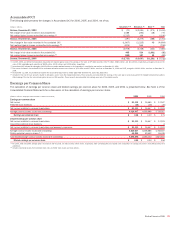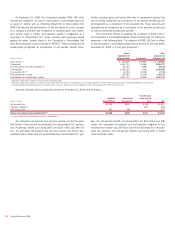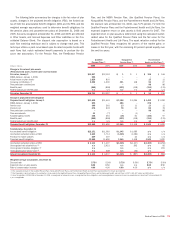Bank of America 2006 Annual Report Download - page 144
Download and view the complete annual report
Please find page 144 of the 2006 Bank of America annual report below. You can navigate through the pages in the report by either clicking on the pages listed below, or by using the keyword search tool below to find specific information within the annual report.
In addition, certain non-U.S. employees within the Corporation are
covered under defined contribution pension plans that are separately
administered in accordance with local laws.
Rewarding Success Plan
In 2005, the Corporation introduced a broad-based cash incentive plan for
associates that meet certain eligibility criteria and are below certain
compensation levels. The amount of the cash award is determined based
on the Corporation’s operating net income and common stock price per-
formance for the full year. During 2006 and 2005, the Corporation
recorded an expense of $237 million and $145 million for this Plan.
Note 17 – Stock-Based Compensation Plans
On January 1, 2006, the Corporation adopted SFAS 123R under the
modified-prospective application.
The compensation cost recognized in income for the plans described
below was $1.0 billion, $805 million and $536 million in 2006, 2005 and
2004, respectively. The related income tax benefit recognized in income
was $382 million, $294 million and $188 million for 2006, 2005 and
2004, respectively.
Prior to the adoption of SFAS 123R, awards granted to retirement-
eligible employees were expensed over the stated vesting period. SFAS
123R requires that the Corporation recognize stock compensation cost
immediately for any awards granted to retirement-eligible employees, or
over the vesting period or the period from the grant date to the date
retirement eligibility is achieved, whichever is shorter. Upon the grant of
awards in the first quarter of 2006, the Corporation recognized approx-
imately $320 million in equity-based compensation due to awards being
granted to retirement-eligible employees.
Prior to the adoption of SFAS 123R, the Corporation presented tax
benefits of deductions resulting from the exercise of stock options as
operating cash flows in the Consolidated Statement of Cash Flows. SFAS
123R requires the cash flows resulting from the tax benefits due to tax
deductions in excess of the compensation cost recognized for those
options (excess tax benefits) to be classified as financing cash flows. The
Corporation classified $477 million in excess tax benefits as a financing
cash inflow for 2006.
Prior to January 1, 2006, the Corporation estimated the fair value of
stock options granted on the date of grant using the Black-Scholes option-
pricing model. On January 1, 2006, the Corporation began using a lattice
option-pricing model to estimate the grant date fair value of stock options
granted. The following table presents the assumptions used to estimate
the fair value of stock options granted on the date of grant using the lat-
tice option-pricing model for 2006. Lattice option-pricing models
incorporate ranges of assumptions for inputs and those ranges are dis-
closed in the following table. The risk-free rate for periods within the con-
tractual life of the stock option is based on the U.S. Treasury yield curve in
effect at the time of grant. Expected volatilities are based on implied vola-
tilities from traded stock options on the Corporation’s common stock,
historical volatility of the Corporation’s common stock, and other factors.
The Corporation uses historical data to estimate stock option exercise and
employee termination within the model. The expected term of stock
options granted is derived from the output of the model and represents
the period of time that stock options granted are expected to be out-
standing. The following table also includes the assumptions used to esti-
mate the fair value of stock options granted on the date of grant using the
Black-Scholes option-pricing model for 2005 and 2004. The estimates of
fair value from these models are theoretical values for stock options and
changes in the assumptions used in the models could result in materially
different fair value estimates. The actual value of the stock options will
depend on the market value of the Corporation’s common stock when the
stock options are exercised.
2006 2005 2004
Risk-free interest rate
4.59 – 4.70%
3.94% 3.36%
Dividend yield
4.50
4.60 4.56
Expected volatility
17.00 – 27.00
20.53 22.12
Weighted-average volatility
20.30
n/a n/a
Expected lives (years)
6.5
65
n/a = not applicable
The Corporation has equity compensation plans that were approved
by its shareholders. These plans are the Key Employee Stock Plan and the
Key Associate Stock Plan. Additionally one equity compensation plan
(2002 Associates Stock Option Plan) was not approved by the Corpo-
ration’s shareholders. Descriptions of the material features of these plans
follow.
Key Employee Stock Plan
The Key Employee Stock Plan, as amended and restated, provided for dif-
ferent types of awards. These include stock options, restricted stock
shares and restricted stock units. Under the plan, ten-year options to
purchase approximately 260 million shares of common stock were granted
through December 31, 2002, to certain employees at the closing market
price on the respective grant dates. Options granted under the plan gen-
erally vest in three or four equal annual installments. At December 31,
2006, approximately 66 million options were outstanding under this plan.
No further awards may be granted.
Key Associate Stock Plan
On April 24, 2002, the shareholders approved the Key Associate Stock
Plan to be effective January 1, 2003. This approval authorized and
reserved 200 million shares for grant in addition to the remaining amount
under the Key Employee Stock Plan as of December 31, 2002, which was
approximately 34 million shares plus any shares covered by awards under
the Key Employee Stock Plan that terminate, expire, lapse or are cancelled
after December 31, 2002. Upon the FleetBoston merger, the shareholders
authorized an additional 102 million shares and on April 26, 2006, the
shareholders authorized an additional 180 million shares for grant under
the Key Associate Stock Plan. At December 31, 2006, approximately
135 million options were outstanding under this plan. Approximately
18 million shares of restricted stock and restricted stock units were
granted in 2006. These shares of restricted stock generally vest in three
equal annual installments beginning one year from the grant date. The
Corporation incurred restricted stock expense of $778 million, $486 mil-
lion, and $288 million in 2006, 2005 and 2004.
2002 Associates Stock Option Plan
The Bank of America Corporation 2002 Associates Stock Option Plan was
a broad-based plan that covered all employees below a specified executive
grade level and was not approved by the Corporation’s shareholders.
Under the plan, eligible employees received a one-time award of a pre-
determined number of options entitling them to purchase shares of the
Corporation’s common stock. All options are nonqualified and have an
exercise price equal to the fair market value on the date of grant. Approx-
imately 108 million options were granted on February 1, 2002. The award
included two performance-based vesting triggers, which were subsequently
achieved. At December 31, 2006, approximately 5 million options were
outstanding under this plan. The options expire on January 31, 2007. No
further awards may be granted.
142
Bank of America 2006
























